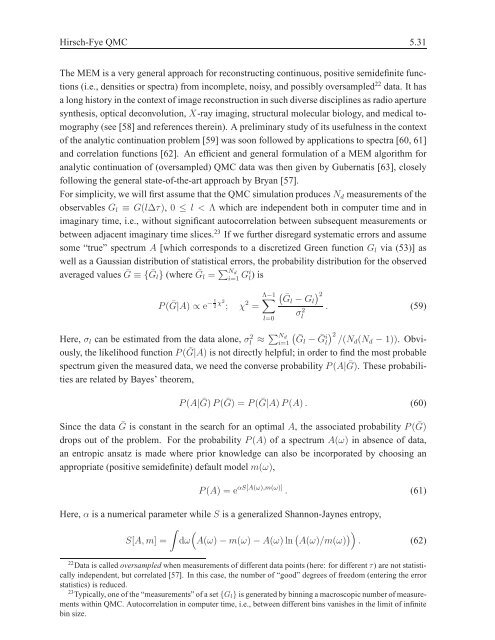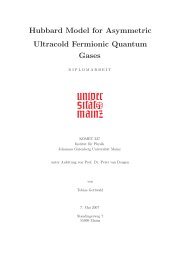5 Hirsch-Fye quantum Monte Carlo method for ... - komet 337
5 Hirsch-Fye quantum Monte Carlo method for ... - komet 337
5 Hirsch-Fye quantum Monte Carlo method for ... - komet 337
You also want an ePaper? Increase the reach of your titles
YUMPU automatically turns print PDFs into web optimized ePapers that Google loves.
<strong>Hirsch</strong>-<strong>Fye</strong> QMC 5.31<br />
The MEM is a very general approach <strong>for</strong> reconstructing continuous, positive semidefinite functions<br />
(i.e., densities or spectra) from incomplete, noisy, and possibly oversampled22 data. It has<br />
a long history in the context of image reconstruction in such diverse disciplines as radio aperture<br />
synthesis, optical deconvolution,X-ray imaging, structural molecular biology, and medical tomography<br />
(see [58] and references therein). A preliminary study of its usefulness in the context<br />
of the analytic continuation problem [59] was soon followed by applications to spectra [60, 61]<br />
and correlation functions [62]. An efficient and general <strong>for</strong>mulation of a MEM algorithm <strong>for</strong><br />
analytic continuation of (oversampled) QMC data was then given by Gubernatis [63], closely<br />
following the general state-of-the-art approach by Bryan [57].<br />
For simplicity, we will first assume that the QMC simulation producesNd measurements of the<br />
observables Gl ≡ G(l∆τ), 0 ≤ l < Λ which are independent both in computer time and in<br />
imaginary time, i.e., without significant autocorrelation between subsequent measurements or<br />
between adjacent imaginary time slices. 23 If we further disregard systematic errors and assume<br />
some “true” spectrum A [which corresponds to a discretized Green function Gl via (53)] as<br />
well as a Gaussian distribution of statistical errors, the probability distribution <strong>for</strong> the observed<br />
averaged values ¯ G ≡ { ¯ Gl} (where ¯ Gl = � Nd<br />
i=1 Gi l<br />
) is<br />
P( ¯ G|A) ∝ e −1<br />
2 χ2<br />
; χ 2 �Λ−1<br />
=<br />
l=0<br />
� �<br />
¯Gl 2<br />
−Gl<br />
σ 2 l<br />
. (59)<br />
Here, σl can be estimated from the data alone, σ2 l ≈ � � Nd ¯Gl<br />
i=1 − ¯ Gi �2/(Nd(Nd l − 1)). Obviously,<br />
the likelihood functionP( ¯ G|A) is not directly helpful; in order to find the most probable<br />
spectrum given the measured data, we need the converse probabilityP(A| ¯ G). These probabilities<br />
are related by Bayes’ theorem,<br />
P(A| ¯ G)P( ¯ G) = P( ¯ G|A)P(A). (60)<br />
Since the data ¯ G is constant in the search <strong>for</strong> an optimal A, the associated probability P( ¯ G)<br />
drops out of the problem. For the probability P(A) of a spectrum A(ω) in absence of data,<br />
an entropic ansatz is made where prior knowledge can also be incorporated by choosing an<br />
appropriate (positive semidefinite) default modelm(ω),<br />
P(A) = e αS[A(ω),m(ω)] . (61)<br />
Here, α is a numerical parameter whileS is a generalized Shannon-Jaynes entropy,<br />
� �<br />
S[A,m] = dω A(ω)−m(ω)−A(ω)ln � A(ω)/m(ω) ��<br />
. (62)<br />
22 Data is called oversampled when measurements of different data points (here: <strong>for</strong> differentτ) are not statistically<br />
independent, but correlated [57]. In this case, the number of “good” degrees of freedom (entering the error<br />
statistics) is reduced.<br />
23 Typically, one of the “measurements” of a set{Gl} is generated by binning a macroscopic number of measurements<br />
within QMC. Autocorrelation in computer time, i.e., between different bins vanishes in the limit of infinite<br />
bin size.













